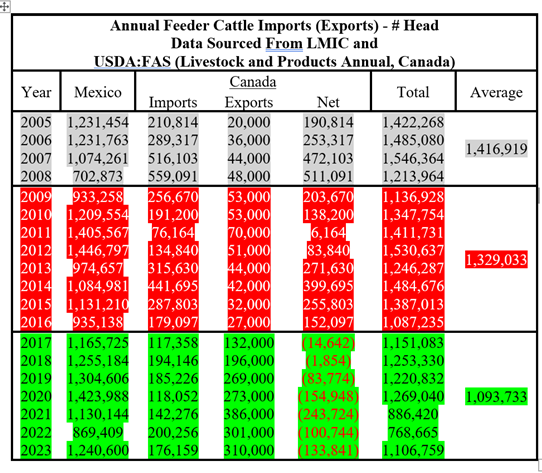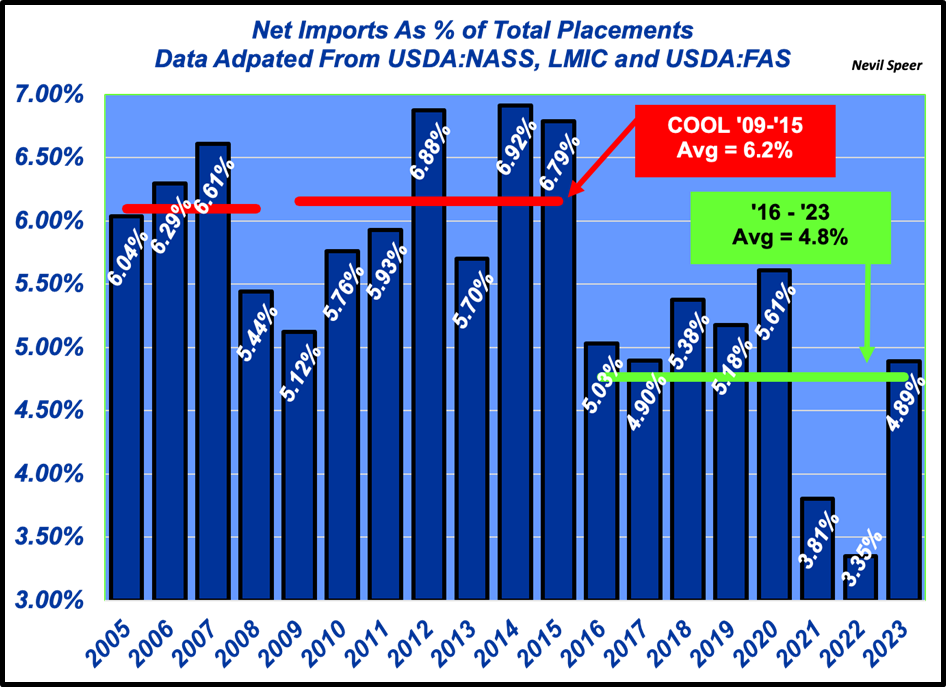Speer: Yelling Imports in a Crowded Salebarn

Don’t Blame Trade: My previous column highlighted one of R-CALF’s recent weekly addresses: “Free trade distorts domestic cattle prices.” The discussion countered the ranch group’s various misrepresentations regarding trade data and subsequent inference for the market. Bottomline: it’s not trade that distorts markets, but rather protectionism.
Feeder Cattle: My column focused primarily on fed trade. It’s important to include some context around the feeder market, too. R-CALF wants us to believe imports are responsible for the market’s recent break: “Data show that 600-weight [sic] calves lost about the same amount [$15/cwt] since July.” A couple of items are significant to note.
First, some levity: a “600-weight” calf would cross the scales at 60,000 lb! Second and more substantively, let’s not confuse imports with seasonality. The market for a 500-to-600 lb calf generally peaks in mid-summer (July) and steadily declines through October. Calf supply surges through fall and the bulk of those placements being marketed AFTER the fed market’s spring high. Hence, the feeder cattle market is expected to decline from summer through the fall run.
Trade: The table below details annual feeder cattle imports including USDA’s export estimate. Several important trends emerge from the data:
- During the past several years, Canadian feeder cattle trade balance has actually turned positive. USDA explains it this way: “Canadian feed lots continue to maintain efficiency by purchasing U.S. feeder cattle rather than returning with empty trucks when delivering cattle to the United States”.
- Feeder cattle imports in ‘23 were indeed higher year-over-year, but that’s compared against ‘22’s low-water mark.

COOL: During the seven years COOL was in effect (’09-’15), net feeder cattle imports averaged ~1.33M head annually. However, in the seven years since the average is only ~1.09M head (a difference of ~235,000 head annually). And while this year’s imports are ahead of last year, the total falls below six-out-of-seven years while COOL was in effect.
Alternatively, let’s view net imports as percentage of total placements (as detailed in the graph below). The rate during 2023 equals 4.89% - below even the lowest rate during COOL (2009 at 5.12%). Moreover, the average during COOL was 6.2%; since that time the import portion of total placements has declined to 4.8%.

Net takeaway. R-CALF: a) remains an ardent supporter of COOL (trade limiting); b) argues free trade distorts the market, and c) fails to acknowledge imports have actually declined (both in absolute and relative terms) since 2015. That is, the free market is working on behalf of their position – yet the ranch group continues to beat the drum of protectionism.
Economic Freedom: Now consider that Canada and Mexico combine for roughly $56B in ag purchases from the United States. Efforts to restrict free trade – just because it’s popular among your membership – is destructive. R-CALF wants selective protection. But that risks retribution from our trading partners – at the expense of another ag commodity.
However, as noted here, what really matters are the principles:
Imports and exports [both product and cattle] create value and provide opportunity for all trading partners, thereby underpinning the very reason international trade exists in the first place. But all else aside, what’s most important is the overarching principle of a free market, and the fact that international trade is integral to economic freedom.
Shouting Fire: R-CALF thrives on a protectionist message. But it’s bad policy. Markets aren’t distorted by free trade; they’re distorted by protectionism. At best, the anti-trade message amounts to nothing more than murmuring. More significantly, the rhetoric represents false reporting that can have real implications (e.g. COOL). Given that reality, the responsible outcome should be to stop yelling imports in a crowded salebarn.
Nevil Speer is an independent consultant based in Bowling Green, KY. The views and opinions expressed herein do not reflect, nor are associated with in any manner, any client or business relationship. He can be reached at nevil.speer@turkeytrack.biz.







